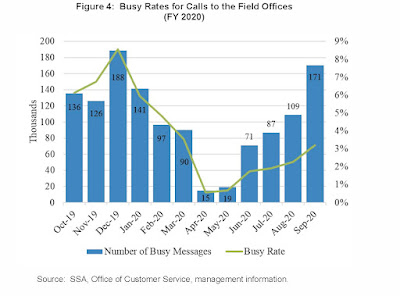From the Washington Post:
NASHVILLE — The first cars bearing the needy pulled into the parking lot as the lights went on in the squat brick Social Security office, three miles north of the luxury condos and boutique hotels rising in booming Music City.
It was 9 a.m., and a flier taped to the glass double doors announced business hours until 4 p.m., Monday through Friday. An American flag fluttered at the curb.
But the office did not open for business, except for a lucky few who gained special entry, for what was then the 605th day since it had been sealed shut to protect its employees and customers from the coronavirus. …
Even as courthouses, motor vehicle and veterans’ benefits offices, and most other parts of the government that directly serve the public have reopened 21 months into the covid crisis, the Social Security Administration remains mostly closed to in-person service, its workers at home, denying vital assistance to most of the disabled, poor and elderly who have long relied on their local office to navigate one of the government’s most complex benefits systems. The unintended consequence: The federal government’s lengthy effort to protect the health of its workers and the public has instead wounded many of those in greatest need of its services. …
With 1,230 field offices normally visited by 43 million people a year largely shut, applying for disability or getting a Social Security card to secure a new job or other services requires finding a way to get online, waiting on hold on the phone for lengthy periods or relying on spotty mail service. Often, statistics show, Americans in need are simply giving up.
Applications and benefit awards under the antipoverty disability program called Supplemental Security Income have plummeted to the lowest level in 22 years, down 29 percent from July 2020 to April 2021 compared with the same period a year earlier, according to internal agency data and outside research.
Another group — disabled people who at one point were able to work but who now have turned to the federal disability system — saw a 17 percent drop in awards, according to an analysis of agency data by David Weaver, a former associate commissioner in the agency’s Office of Research, Demonstration and Employment Support.
The number applying for SSI benefits for disabled children, disabled adults and the elderly plummeted 51 percent, 32 percent, and 55 percent, respectively, just one month after field offices closed, internal agency data shows, a decline that continued through August 2020, the most recent month for which numbers were available. The drop-off was most pronounced for those with limited English and the elderly….
[T]he Social Security inspector general reported this month that just 51 percent of calls from the public were answered in fiscal 2020.
After months of criticism from disability advocates and Republicans in Congress who contend that the Biden administration is kowtowing to its unions in allowing the closures — and delaying reopenings across the government — the agency released tentative plans last month to begin returning its staff of 60,000 to their offices in January. But employees in some offices will be given wide berth to continue working from home permanently up to five days a week, with two days allowed for the field office staff. …
“Social Security is disappearing from public view,” Weaver said, pointing to the number of people who receive benefits: “It’s going to eventually reach a point where, do you want a problem with the unions or do you want a problem with 70 million people?” …
By the way, I’ve decided to stop allowing comments that say that employee productivity has increased while Social Security employees have been working from home. I have seen no proof of that. As a general matter, it appears to be misleading if not a complete fabrication. Decreased staffing is a big problem for Social Security but it’s not the only one. Working from home is also causing big problems.






























